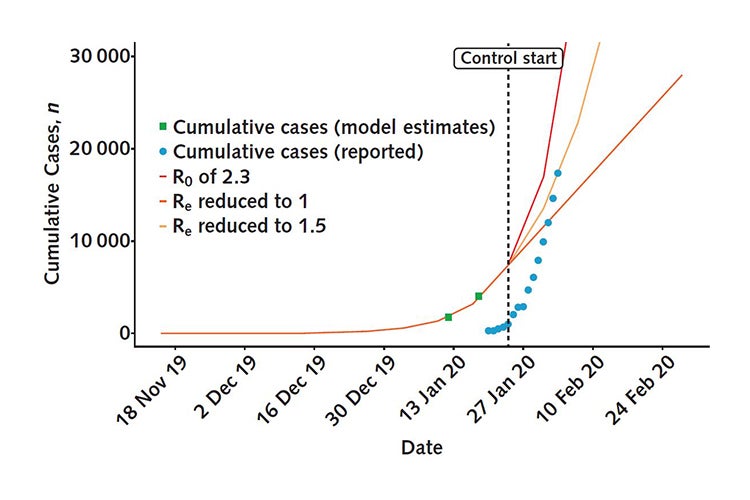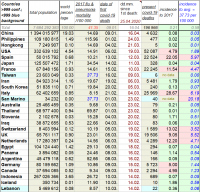Thanks again Hebbeh. Maybe you and gamesguru are right. I think Hip is also in your camp. I personally don't think you guys are right. I could be wrong on this. What is clear is that your camp seems to have an agenda (which Mind noticed too). It's like you just want it to be worse than it is. Why?

Coronavirus information with context
#481
Posted 24 April 2020 - 02:31 AM
#482
Posted 24 April 2020 - 02:54 AM
Thanks again Hebbeh. Maybe you and gamesguru are right. I think Hip is also in your camp. I personally don't think you guys are right. I could be wrong on this. What is clear is that your camp seems to have an agenda (which Mind noticed too). It's like you just want it to be worse than it is. Why?
You wouldn't believe that if you knew me. I have close friends in foreign countries that are really hurting from this and I'm helping in every way I can. Everybody I know is going to feel the pain in multiple ways or not come through this unscathed. Life will never be the same for some. But you just can't sugar coat the truth no matter how much it hurts. I truly pray for the world.
#483
Posted 24 April 2020 - 03:31 AM
Thanks again Hebbeh. Maybe you and gamesguru are right. I think Hip is also in your camp. I personally don't think you guys are right. I could be wrong on this. What is clear is that your camp seems to have an agenda (which Mind noticed too). It's like you just want it to be worse than it is. Why?
We're just being cautious like he said. The pandemic has been going for almost two months, but my message hasn't changed.
We're asking you to stay home—save a life.
Let's look at this new inference study from Sweden.
You can see what the number of cases reported daily looks like as a function of the "% unreported" parameter. So basically as we detect fewer of the total cases (50% on left vs. 95% undetected on the right) the number of new daily reports remains high and steady for a longer time[1], due to failed contact tracing among other factors. Translated study link.
 Screenshot_2020-04-23 Skattning av peakdag och antal infekterade i covid-19-utbrottet i Stockholms län februari-april 2020 ...(3).png 19.89KB
0 downloads
Screenshot_2020-04-23 Skattning av peakdag och antal infekterade i covid-19-utbrottet i Stockholms län februari-april 2020 ...(3).png 19.89KB
0 downloads Screenshot_2020-04-23 Skattning av peakdag och antal infekterade i covid-19-utbrottet i Stockholms län februari-april 2020 ...(2).png 19.96KB
0 downloads
Screenshot_2020-04-23 Skattning av peakdag och antal infekterade i covid-19-utbrottet i Stockholms län februari-april 2020 ...(2).png 19.96KB
0 downloads
But we're seeing more of a flattening in Korea and Italy[1], so this suggests it's closer to the 1:2 regime than the 1:20,
 Screenshot_2020-04-23 South Korea Coronavirus 10,708 Cases and 240 Deaths - Worldometer.png 18.46KB
0 downloads
Screenshot_2020-04-23 South Korea Coronavirus 10,708 Cases and 240 Deaths - Worldometer.png 18.46KB
0 downloads Screenshot_2020-04-23 Italy Coronavirus 189,973 Cases and 25,549 Deaths - Worldometer.png 20.04KB
0 downloads
Screenshot_2020-04-23 Italy Coronavirus 189,973 Cases and 25,549 Deaths - Worldometer.png 20.04KB
0 downloads
Especially Korea, they seem to be finding nearly everyone—with or without symptoms.
#484
Posted 24 April 2020 - 04:14 AM
Common infections like influenza can also cause strokes in younger people.
Influenza-like Illness as a Trigger for Ischemic Stroke
https://pubmed.ncbi....h.gov/29687022/
#485
Posted 24 April 2020 - 07:18 AM
You seem to disbelieve any data that indicates a lower mortality rate. All of these studies (dozens now) cannot be garbage. Real scientists, real professors, and real epidemiologists in multiple countries are conducting these studies. Are they all dimwits?
Well, to be fair, I think there are multiple mortality rates. They can be classified into three categories.
The mortality rate with an unoverwhelmed modern healthcare system is likely to be the lowest and the number seems to be around 1%.
The mortality rate with an overwhelmed modern healthcare system is like to be higher than 1% but I suppose it is hard to conduct research on the actual number.
Then finally we have the mortality rate when nothing is done (e,g. aborigines living in the amazon) which will then be the upper bound for the mortality rate.
Of course, in between, there are many variables (population age distribution, advanceness of healthcare system, etc) that contribute to a spectrum of mortality rates.
#486
Posted 24 April 2020 - 11:44 AM
Well, to be fair, I think there are multiple mortality rates. They can be classified into three categories.
This is an interesting point, I'm not sure about it though. According to U.S. data only ~5% of patients are placed on a ventilator, and of those, 88% never come off it, raising questions about their usefulness. Granted, the preceding oxygen therapy may be more life-saving, but it seems less of a medical scarcity than ventilators. I don't see deaths as going up by more than 1.5x when doctors have their hands full. This is a disease which almost chooses its victims up front, described by some yet unknown sequence of vulnerable traits.
Sri Lanka, Nepal and Thailand all reported their first cases before Feb 1st, but none have reported over a 2% fatality rate or over 1 death per 1 million residents. Pretty amazing, considering how their health care systems are nothing special.
I think more than anything with overwhelmed systems you see a shortage of tests: UK, France, Italy and Spain are all reporting > 10% fatality rate. I think it is paired with an underestimate of deaths as well but much less (20-40% of deaths are either un-diagnosed, people found later in their homes, etc).
#487
Posted 24 April 2020 - 03:08 PM
It appears the key to high mortality in the US hospitals is the reluctance to provide supplemental oxygen before putting the patients on ventilators.
Someone (pamojja?) posted a video of a 'respiratory therapist' in one of these covid threads. Just now I looked but could not find it. The guy in a mask, in front of a room full of ventilators and those other supplemental O2 machines, says that they are under orders not to use those other O2 machines (sorry, don't recall what they are called). Instead, they wait until a patient deteriorates enough to put him on a ventilator.
It is feared that the use of supplemental O2 will spread the virus and contaminate the facility, because O2 is delivered under pressure.
This is not the first time I heard this notion. I saw at least two other ER docs saying the same thing; i.e. that they avoid using supplemental O2 machines and go strait for ventilators which do not present the same danger of spreading the virus (except, apparently, during the intubation itself).
Essentially they are killing the patients.
shocking!
#488
Posted 24 April 2020 - 05:06 PM
It appears the key to high mortality in the US hospitals is the reluctance to provide supplemental oxygen before putting the patients on ventilators.
Someone (pamojja?) posted a video of a 'respiratory therapist' in one of these covid threads. Just now I looked but could not find it. The guy in a mask, in front of a room full of ventilators and those other supplemental O2 machines, says that they are under orders not to use those other O2 machines (sorry, don't recall what they are called). Instead, they wait until a patient deteriorates enough to put him on a ventilator.
It is feared that the use of supplemental O2 will spread the virus and contaminate the facility, because O2 is delivered under pressure.
This is not the first time I heard this notion. I saw at least two other ER docs saying the same thing; i.e. that they avoid using supplemental O2 machines and go strait for ventilators which do not present the same danger of spreading the virus (except, apparently, during the intubation itself).
Essentially they are killing the patients.
shocking!
A lot of doctors in the U.S. have questioned the use of ventilators. 80 to 90% of people who go on the ventilator die. The doctors notice, but national media outlets have tended to shame anyone who strays from the orthodoxy. Tis a shame, innovation and new ideas are needed during a crisis. I think there was a "media-momentum" that ventilators are the only answer, and there was a political battle over ventilators being in short supply. It could be a preventable tragedy, considering some doctors have found that passive oxygen has worked in many cases (like Boris Johnson).
#489
Posted 24 April 2020 - 05:11 PM
It landed here around January 10th.
The first 5% is the slowest. Look at this University of Toronto model how nothing happens all of November in Wuhan.
So you see there's about a 9 week period between patient zero and hospitals reporting ~100 deaths. If California was seeded in early January, it wouldn't be til March that warning signs would become obvious. Which is exactly consistent with the true narrative. Each day lock-down is postponed, exponentially more people die.
It doesn't matter even if China had "millions of people travel in and out". Even if they seeded 170 sick people in Los Angeles, it only speeds up the curve by about 4.5 weeks.
If we truly had the months-long head start you're proposing then we would be further along in the exponential curve—we would have actually hit a "logistic" regime—and deaths would slow down instead of spiking in the weeks after the initial warning signs. The alleged antibody prevalence doesn't make sense on this timeline.
The only way to know for sure is to re-open and see. Looks like Las Vegas wants to make itself a case study, but that may just be a heat of the moment thing.
This graph is based upon suspect Chinese data.
I checked the time between patient zero and 100 deaths in Sweden, Italy, France, and the UK. They were all between 4 and 7 weeks. You can find the data for each country on Wikipedia.
This virus is more infectious than most. 9 weeks from patient zero to 100 deaths just doesn't seem likely.
#490
Posted 24 April 2020 - 05:39 PM
Someone (pamojja?) posted a video of a 'respiratory therapist' in one of these covid threads. Just now I looked but could not find it. The guy in a mask, in front of a room full of ventilators and those other supplemental O2 machines, says that they are under orders not to use those other O2 machines (sorry, don't recall what they are called). Instead, they wait until a patient deteriorates enough to put him on a ventilator.
It is feared that the use of supplemental O2 will spread the virus and contaminate the facility, because O2 is delivered under pressure.
This is not the first time I heard this notion. I saw at least two other ER docs saying the same thing; i.e. that they avoid using supplemental O2 machines and go strait for ventilators which do not present the same danger of spreading the virus (except, apparently, during the intubation itself).
Essentially they are killing the patients.
shocking!
Its here: https://www.longecit...ndpost&p=890465
#491
Posted 24 April 2020 - 06:15 PM
It appears the key to high mortality in the US hospitals is the reluctance to provide supplemental oxygen before putting the patients on ventilators.
Someone (pamojja?) posted a video of a 'respiratory therapist' in one of these covid threads. Just now I looked but could not find it. The guy in a mask, in front of a room full of ventilators and those other supplemental O2 machines, says that they are under orders not to use those other O2 machines (sorry, don't recall what they are called). Instead, they wait until a patient deteriorates enough to put him on a ventilator.
It is feared that the use of supplemental O2 will spread the virus and contaminate the facility, because O2 is delivered under pressure.
This is not the first time I heard this notion. I saw at least two other ER docs saying the same thing; i.e. that they avoid using supplemental O2 machines and go strait for ventilators which do not present the same danger of spreading the virus (except, apparently, during the intubation itself).
Essentially they are killing the patients.
shocking!
Thanks pamojja!
here he is, a bit long-winded and I did not hear him till the end. @3:19
Edited by xEva, 24 April 2020 - 06:17 PM.
#492
Posted 24 April 2020 - 11:01 PM
This graph is based upon suspect Chinese data.
I checked the time between patient zero and 100 deaths in Sweden, Italy, France, and the UK. They were all between 4 and 7 weeks. You can find the data for each country on Wikipedia.
This virus is more infectious than most. 9 weeks from patient zero to 100 deaths just doesn't seem likely.
Suspect in what way?
You seem to be assuming everyone is a super spreader, but those people are outliers. For every person who spreads it to 20, many spread it to none—effective dead ends. The R0 variable is an effective average for this value. R0 itself can fluctuate over time and as social distancing factors change.
Unconstrained, the R0 value is around 3 and the serial interval is about 5-9 days. So for the naive model we have 729 infections at week 6, 6561 at week 8 and 59049 at week 10.
If we use ~50-100 deaths or ~3 deaths daily as a marker for when doctors typically sound the pathogen alarm, it just means patient zero was probably in Italy 2 weeks sooner than we think.
It's impossible to gauge the extent of the outbreak based on a few positives. You need tens of thousands of tests—significant population coverage—before the chances for error become negligible.
See the below chart, which shows the vast differences in days 1, 10, and 30 for four countries all in the very early days of coronavirus, when the virus was free to spread. These weren't actual patient zeroes, they weren't real indicators of if there were 3 or 70 people sick, they were just early warning signs, and outcome results varied for each.

It's also frightening to hear the antibody studies exploding in the media over the last day or two.
At least CNN reporter Weijia Jiang still has a voice of caution at 9:50,
#493
Posted 25 April 2020 - 01:01 PM
It's also frightening to hear the antibody studies exploding in the media over the last day or two.
Not sure why it is frightening. It is the natural progression of testing. There is an explosion of antibody testing around the world in many countries because it is important scientific data. Why would anyone NOT want to see the results of antibody testing? More antibody testing is coming every day. This is a good thing. Knowledge about how many people had been infected will help determine effective public policy. I don't blame people for being cautiously optimistic when they see the early antibody testing results. I am hoping these early results are valid. It would be great for everyone if the mortality rate is lower than speculated.
Edited by Mind, 25 April 2020 - 01:02 PM.
#494
Posted 25 April 2020 - 01:22 PM
Why would anyone NOT want to see the results of antibody testing? More antibody testing is coming every day.
Yes and at a point where the uncertainty in these tests is far greater than the supposed incidence of the disease, it is frustrating to say the least to see the media giving false hopes.
If I told you I was 4 feet tall, plus or minus 3 feet. That's not very useful information is it
#495
Posted 25 April 2020 - 02:52 PM
Antibody testing for #COVID19 could eventually be a critical tool for reopening the economy. But the tests currently on the market have not been validated by the #FDA. Many have been fraudulently marketed and others simply do not work.
CNN - House Democrats investigating unproven Covid-19 antibody tests
— Congressman Raja Krishnamoorthi (@CongressmanRaja) April 25, 2020
Edited by gamesguru, 25 April 2020 - 02:53 PM.
#496
Posted 26 April 2020 - 11:16 AM
What is up with Singapore?
An exponential increase in cases over the last 2 weeks or so, much faster than other countries (even the U.S), yet still only 12 deaths.
#497
Posted 26 April 2020 - 11:33 AM
What is up with Singapore?
An exponential increase in cases over the last 2 weeks or so, much faster than other countries (even the U.S), yet still only 12 deaths.
They recently acquired new contracts in testing and have ramped up 5x. Also the initial reflex of Hong Kong and Singapore was strong due to fears lingering from the 2003 outbreak, but late March mitigation fatigue set in and people largely returned to normal life. Now they are facing a second wave.
Singapore is also not allowing any visitors to nursing homes, so likely have isolated much of the vulnerable population.
Also deaths sometimes don't occur or aren't reported for 3 weeks after initial diagnosis.
Helmet-based ventilation and oxygen masks are more common in places like Korea and Hong Kong, where few are sick and they can be provided special treatment.
You saw the same in Germany—aggressive, early testing, careful isolation of vulnerable populations, and providing specific care—but now time has caught up with even Germany.
#498
Posted 26 April 2020 - 12:01 PM
Yes, increase in testing will automatically increase the number of cases reported. Many countries had limited testing capacities initially, then managed to be able to do more later on. There are also countries in Africa and South America that are reporting almost no cases, but you can bet that they didn’t have any capacity for testing. That’s another problem too, tests are expensive to acquire for some poorer countries, but there are research going on into making very cheap ones that would still be reliable. Not an easy task considering that even the “regular” ones seem to have disheartening rates of reliability.
Edited by BlueCloud, 26 April 2020 - 12:04 PM.
#499
Posted 26 April 2020 - 01:10 PM
What is up with Singapore?
An exponential increase in cases over the last 2 weeks or so, much faster than other countries (even the U.S), yet still only 12 deaths.
Singapore put 250,000 foreign workers in packed dormitories that houses 10-12 people in a room. Since they were treated as sub-humans there, so their government forgot about their potential to be a virus source and now Singapore is bitten at their ass. About 95% new cases are from the dormitories. However, the non-dormitory 5% is still way more than cases than South Korea, HK or Taiwan.
#500
Posted 26 April 2020 - 06:57 PM
If you're of retirement age and catch COVID-19, expect your life expectancy to be cut 11-13 years short. This disease is not just killing people with one foot already in the grave. I'm really amazed at the number of people on this site, of all places, that appear to feel this is an acceptable trade off by putting finances over life (as long as it's not their life).
AbstractBackground: The COVID-19 pandemic is responsible for increasing deaths globally. Most estimates have focused on numbers of deaths, with little direct quantification of years of life lost (YLL) through COVID-19. As most people dying with COVID-19 are older with underlying long-term conditions (LTCs), some have speculated that YLL are low. We aim to estimate YLL attributable to COVID-19, before and after adjustment for number/type of LTCsMethods: We first estimated YLL from COVID-19 using standard WHO life tables, based on published age/sex data from COVID-19 deaths in Italy. We then used aggregate data on number/type of LTCs to model likely combinations of LTCs among people dying with COVID-19. From these, we used routine UK healthcare data to estimate life expectancy based on age/sex/different combinations of LTCs. We then calculated YLL based on age, sex and type of LTCs and multimorbidity count.Results: Using the standard WHO life tables, YLL per COVID-19 death was 14 for men and 12 for women. After adjustment for number and type of LTCs, the mean YLL was slightly lower, but remained high (13 and 11 years for men and women, respectively). The number and type of LTCs led to wide variability in the estimated YLL at a given age (e.g. at ≥80 years, YLL was >10 years for people with 0 LTCs, and <3 years for people with ≥6).Conclusions: Deaths from COVID-19 represent a substantial burden in terms of per-person YLL, more than a decade, even after adjusting for the typical number and type of LTCs found in people dying of COVID-19. The extent of multimorbidity heavily influences the estimated YLL at a given age. More comprehensive and standardised collection of data on LTCs is needed to better understand and quantify the global burden of COVID-19 and to guide policy-making and interventions.
#501
Posted 26 April 2020 - 07:31 PM
Also the initial reflex of Hong Kong and Singapore was strong due to fears lingering from the 2003 outbreak, but late March mitigation fatigue set in and people largely returned to normal life. Now they are facing a second wave.
This myopic look at a few countries, which most aren't even as affected by covid-deaths than usually by the flu, is not really giving any insights at all. How can one even speak of a second wave, when there wasn't even really a first?
Better look at all of them, already more than 110 countries by yesterday, 108 of which already today advanced to 1 month or longer since each first death, and only 14 countries really affected by higher covid mortality, than usually year after year from the flu: Spain, France, Italy, San Marino, Switzerland, UK, Netherlands, Belgium, Sweden, Ireland, Luxembourg, Sint Maarten, Andorra, Channel Islands.
#502
Posted 26 April 2020 - 08:12 PM
If you're of retirement age and catch COVID-19, expect your life expectancy to be cut 11-13 years short. This disease is not just killing people with one foot already in the grave. I'm really amazed at the number of people on this site, of all places, that appear to feel this is an acceptable trade off by putting finances over life (as long as it's not their life).
The younger you die, the more years you'll lose. See Table 2. But the younger you are, the less chance that you'll die. All of this is obvious.
What might not be so obvious is that if SENS/aging research is significantly slowed down by the lockdowns, millions of people will miss out on LEV. And that means that the years of life lost (the YLLs mentioned in the paper) could be nearly infinite.
Edited by Florin, 26 April 2020 - 08:20 PM.
#503
Posted 26 April 2020 - 08:30 PM
What might not be so obvious is that if SENS/aging research is significantly slowed down by the lockdowns, millions of people will miss out on LEV. And that means that the years of life lost (the YLLs mentioned in the paper) could be nearly infinite.
That's betting on loss of lives today producing expected gains in life extension sometime in the future based on technology that doesn't yet exist and is likely not going to be available anytime soon or even in most of our lifetimes if at all. And provided that imaginary technology is developed, it will only be available for the wealthy among us. That said, I don't see this having an effect on SENS in the long run (which is what we're realistically looking at). In fact, the source of this type of funding has gained wealth (at the expense of the rest of us) during this temporary shutdown.
#504
Posted 26 April 2020 - 09:15 PM
That's betting on loss of lives today producing expected gains in life extension sometime in the future based on technology that doesn't yet exist and is likely not going to be available anytime soon or even in most of our lifetimes if at all. And provided that imaginary technology is developed, it will only be available for the wealthy among us. That said, I don't see this having an effect on SENS in the long run (which is what we're realistically looking at).
Many people on this site take SENS and other kinds of aging research seriously and don't buy into bogus objections.
And why don't we apply the reasoning in the quote above to all biomedical research? How many will die because the traditional kind of cancer (or any other major disease) research is shut down? Hmmm, well, the technology to cure cancer doesn't exist yet and is probably never going to exist. And even if this imaginary technology is ever developed a million years from now, it'll be only for the rich! So, why don't we permanently shut down all medical, non-communicable disease research, because it's never going to amount to anything anyway, and even if it does, it'll only be for the rich! Imagine how many bed nets we could buy with the money we'd save!
In fact, the source of this type of funding has gained wealth (at the expense of the rest of us) during this temporary shutdown.
Really? How?
Edited by Florin, 26 April 2020 - 10:04 PM.
#505
Posted 26 April 2020 - 10:46 PM
Many people on this site take SENS and other kinds of aging research seriously and don't buy into bogus objections.
Bogus? How so?
And why don't we apply the reasoning in the quote above to all biomedical research? How many will die because the traditional kind of cancer (or any other major disease) research is shut down? Hmmm, well, the technology to cure cancer doesn't exist yet and is probably never going to exist. And even if this imaginary technology is ever developed a million years from now, it'll be only for the rich! So, why don't we permanently shut down all medical, non-communicable disease research, because it's never going to amount to anything anyway, and even if it does, it'll only be for the rich! Imagine how many bed nets we could buy with the money we'd save!
Now that is a bogus objection to your obvious bias.
BTW, please post some evidence that any medical research has been negatively impacted.
Really? How?
ECON 101 - It takes money to make money. The wealthy have no lack of bargains to invest in and expand their wealth while the rest will be forced to sit by and watch their finances dwindle. Even President Trump has said the stock market is looking very good (depending on your position). Make no mistake that there will be money made on this bear market just as in the past. But of course, that requires wealth to make wealth. In the business sphere, those unable to weather the downturn and forced out will make opportunities in many ways for the wealthy to capitalize on. There has been no lack of the disportionate effect of COVID-19 between the haves and have nots and media coverage of and including effects on personal wealth distribution. A simple google will provide no lack of reading material.
https://www.nytimes....inequality.html
https://nymag.com/in...600-checks.html
#506
Posted 27 April 2020 - 01:38 AM
Seems Sweden is having second thoughts.
Sweden Health Chief Admits ‘It’s Not Over’ As Coronavirus Cases LeapSweden's state epidemiologist Anders Tegnell has said the number of COVID-19 deaths in Sweden have been higher than expected.
Sweden’s state epidemiologist Anders Tegnell has announced a record daily high of coronavirus cases for the second consecutive day. 812 positive COVID-19 tests were reported during the prior 24 hours, taking the overall total to 17,567. Tegnell had previously insisted on several occasions that the spread of the virus was slowing.
The country has come under fire from scientists in Sweden and around the world for its relatively relaxed approach to tackling the virus compared to other European countries.
More than 2,000 deaths in Sweden
Following an additional 131 deaths reported in the last 24 hours, Sweden’s COVID-19 death toll now stands at 2,152. The numbers were given at the latest daily coronavirus press briefing from the Swedish Public Health Agency.
The Swedish Public Health Agency said it was “clear” that the number of deaths in Sweden this year will be significantly higher than during a regular flu season. During weeks 13 and 14 of 2020, there were approximately 1,000 additional deaths above the expected amount.
“There have been more deaths than expected. It is definitely not over. We see that especially in the small rise in Stockholm again,” said Tegnell. The jump in positive cases comes just 48 hours after the controversial withdrawal of a report that suggested 600,000 Stockholm residents will have been infected by May 1.
When questioned, Tegnell said it was “hard to know” if increased traveling and public contact during the Easter vacation period was to blame. He pointed out that increased testing for healthcare professionals and the elderly could be at least partly behind the increase in reported infections.
In somewhat positive news, those testing positive in recent weeks are trending younger than previously. Tegnell said that this places them at lower-risk of developing serious illness.
Too early to relax
Tegnell also said it far too early for life to return to normal. His words were echoed by the Swedish Civil Contingencies Agency (MSB), which warned of an increase in cases if citizens do not comply with government guidance.
“There is a significant risk that people start to relax prematurely and stop following guidelines. Continue to follow the authorities' advice and be part of the solution,” said Svante Werger, special adviser at MSB, according to Swedish newspaper Aftonbladet.
While Sweden has avoided some of the more extreme lockdown measures introduced by its Nordic neighbors, Swedish people have nevertheless been encouraged to stay home and implement social distancing. However, with many shops, gyms, restaurants and bars remaining open, the temptation has proved too much for many.
This has led to the Mayor to Stockholm Anna König Jerlmyr to warn the owners of restaurants and bars that they risk closure unless they ensure social distancing guidelines can be followed: “In the past week, we have received reports that people in Stockholm are starting to relax and enjoy the weather, and I want to be very clear that the restrictions in place are not just general advice. Let me extremely clear. I don't want to see any crowded outdoor restaurants in Stockholm.”
#507
Posted 27 April 2020 - 02:21 AM
Bogus? How so?
Never gonna happen: Everyone is betting that medical technology will significantly reduce or eliminate all major age-related diseases in their life times. Otherwise, medical research would not exist. Some of us just happen to bet that SENS is a better way to accomplish the same goals. But apparently, you have a crystal ball that says medical research is bound to fail forever.
Only for the rich: Any medical technology that's significantly beneficial has generally been made available to most people and there's no good reason to think that this won't continue.
Now that is a bogus objection to your obvious bias.
Well, it was your objection, not mine. See above. And I'm glad that you now agree that it's bogus.
BTW, please post some evidence that any medical research has been negatively impacted.
I know for a fact that some SENS research has (at least temporarily) been adversely affected by the lockdowns. You'll just have to trust me on that. It's also getting harder to run clinical trials, and there are probably other problems that I haven't taken the time to look for. The point is that medical research is slowing down, and that's not a good thing. The moral calculus as to whether lockdowns are worth it or not isn't as obvious as it seems.
Near-lockdown in the Bay Area ‘ratchets up’ challenges for local biotechs and labs
https://www.statnews...s-biotech-labs/
ECON 101 - It takes money to make money. The wealthy have no lack of bargains to invest in and expand their wealth while the rest will be forced to sit by and watch their finances dwindle. Even President Trump has said the stock market is looking very good (depending on your position). Make no mistake that there will be money made on this bear market just as in the past. But of course, that requires wealth to make wealth. In the business sphere, those unable to weather the downturn and forced out will make opportunities in many ways for the wealthy to capitalize on. There has been no lack of the disportionate effect of COVID-19 between the haves and have nots and media coverage of and including effects on personal wealth distribution. A simple google will provide no lack of reading material.
https://www.nytimes....inequality.html
https://nymag.com/in...600-checks.html
I also know for a fact that the global financial crisis of 2007/2008 led to a dip in SENS research funding. The wealthy generally become less wealthy when the economy tanks, regardless of any bailouts or handouts. And this thing could get a lot worse than the GFC and last for years. So, your claim that SENS/aging research would get more funding as a result of this economic disaster is likely to be bogus as well.
Edited by Florin, 27 April 2020 - 02:31 AM.
#508
Posted 27 April 2020 - 06:33 AM
"Although a number of assumptions need to be reexamined, like age structure in social mixing patterns and in the distribution of mobility, hospitalization, and fatality, we conclude that verifiable evidence exists to support the planning of emergency measures."
The tough containment actions in Italy look to have avoided so far at least 200,000 hospitalizations and reduced contagion transmission by 45%.
 containment Italy.PNG 139.86KB
0 downloads
containment Italy.PNG 139.86KB
0 downloads
Spread and dynamics of the COVID-19 epidemic in Italy: Effects of emergency containment measures. Marino Gattoa, Enrico Bertuzzo, Lorenzo Mari, Stefano Miccoli, Luca Carraro, Renato Casagrandi and Andrea Rinaldo. PNAS, 23 April 2020. DOI: 10.1073/pnas.2004978117
Edited by albedo, 27 April 2020 - 06:36 AM.
#509
Posted 27 April 2020 - 02:01 PM
The moral calculus as to whether lockdowns are worth it or not isn't as obvious as it seems.
Well you're operating under the assumption people will want to go along with SENS and cryopreservation. A lot of people may be against that. If you're going to live that long, it's not sustainable for everyone to have kids, for example, and that's a thing.
You're also not realizing that saving lives may also save the economy. Some of the eminent SENS researchers may be in their 70s, and if we lose just one of them to COVID, we lose decades of wisdom. That wisdom can't just be gotten back the easy way. So in a way, I could definitely see a net positive utility coming out of the temporary lock-downs—no matter really the realm of consideration.
#510
Posted 27 April 2020 - 03:29 PM
The Secret Group of Scientists and Billionaires Pushing Trump on a Covid-19 Plan
They are working around the clock to cull the world’s most promising research for what they describe as a virus-era Manhattan Project
A dozen of America’s top scientists and a collection of billionaires and industry titans say they have the answer to the coronavirus pandemic, and they found a backdoor to deliver their plan to the White House.
The eclectic group is led by a 33-year-old physician-turned-venture capitalist, Tom Cahill, who lives far from the public eye in a one-bedroom rental near Boston’s Fenway Park. He owns just one suit, but he has enough lofty connections to influence government decisions in the war against Covid-19.
These scientists and their backers describe their work as a lockdown-era Manhattan Project, a nod to the World War II group of scientists who helped develop the atomic bomb. This time around, the scientists are marshaling brains and money to distill unorthodox ideas gleaned from around the globe.
They call themselves Scientists to Stop Covid-19, and they include chemical biologists, an immunobiologist, a neurobiologist, a chronobiologist, an oncologist, a gastroenterologist, an epidemiologist and a nuclear scientist. Of the scientists at the center of the project, biologist Michael Rosbash, a 2017 Nobel Prize winner, said, “There’s no question that I’m the least qualified.”
This group, whose work hasn’t been previously reported, has acted as the go-between for pharmaceutical companies looking for a reputable link to Trump administration decision makers. They are working remotely as an ad hoc review board for the flood of research on the coronavirus, weeding out flawed studies before they reach policy makers.
The group has compiled a confidential 17-page report that calls for a number of unorthodox methods against the virus. One big idea is treating patients with powerful drugs previously used against Ebola, with far heftier dosages than have been tried in the past.
The Food and Drug Administration and the Department of Veterans Affairs have already implemented specific recommendations, such as slashing manufacturing regulations and requirements for specific coronavirus drugs.
National Institutes of Health Director Francis Collins told people this month that he agreed with most of the recommendations in the report, according to documents reviewed by The Wall Street Journal and people familiar with the matter. The report was delivered to cabinet members and Vice President Mike Pence, head of the administration’s coronavirus task force.
Dr. Cahill’s primary asset is a young lifetime of connections through his investment firm. They include such billionaires as Peter Thiel, Jim Palotta and Michael Milken—financiers who afforded him the legitimacy to reach officials in the middle of the crisis. Dr. Cahill and his group have frequently advised Nick Ayers, Mr. Pence’s longtime aide, and agency heads through phone calls over the past month.
No one involved with the group stands to gain financially. They say they are motivated by the chance to add their own connections and levelheaded science to a coronavirus battle effort that has, on both state and federal levels, been strained.
“We may fail,” said Stuart Schreiber, a Harvard University chemist and a member of the group. “But if it succeeds, it could change the world.”
Steve Pagliuca, co-owner of the Boston Celtics and the co-chairman of Bain Capital—as well as one of Dr. Cahill’s investors—helped copy edit drafts of their report, and he passed a version to Goldman Sachs Group Inc. Chief Executive David Solomon. Mr. Solomon got it to Treasury Secretary Steven Mnuchin.
The group’s members say they are aware that many of their ideas may not be implemented, and could be ignored altogether by the Trump administration.
This account is based on interviews with scientists, businesspeople, government officials, as well as a review of related documents.
Rest of article at posted link
Also tagged with one or more of these keywords: coronavirus, sars, bird flu, swine flu, west nile virus, covid19, covid-19
Round Table Discussion →
Risks & Survival →
COVID →
Pfizer Hires Top FDA Official Just Weeks After She Leaves AgencyStarted by Daniel Cooper , 27 Feb 2025 |
|

|
||
Round Table Discussion →
Risks & Survival →
COVID →
Help Me Obi-Wan: The Mysterious/Mythical Zinc Sulfate?Started by Dorian Grey , 01 Dec 2024 |
|

|
||
Round Table Discussion →
Risks & Survival →
COVID →
Polio vaccine booster more effective than COVID vaccine (if you had Oral Polio Vaccine as a child).Started by smithx , 06 Aug 2024 |
|

|
||
Round Table Discussion →
Risks & Survival →
COVID →
ArtemisininStarted by joesixpack , 05 Jun 2024 |
|

|
||
Round Table Discussion →
Risks & Survival →
COVID →
COVID-19 pandemic: the aftermathStarted by Galaxyshock , 14 Mar 2024 |
|

|
2 user(s) are reading this topic
0 members, 2 guests, 0 anonymous users
























































